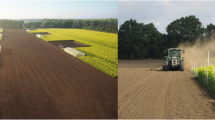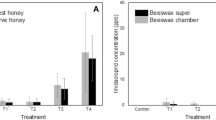Abstract
This paper assessed the potential exposure of bees (Apis mellifera L.) to pesticides during maize (Zea mays L.) sowing with pneumatic drills. Data were derived from tests carried out in field tests, comparing two configurations of a pneumatic precision drill: conventional drill; drill with air deflectors. In addition, static tests simulating the sowing under controlled conditions, were performed on the drill equipped with an innovative system developed at CRA-ING. During the field tests, the concentrations in the air of the active ingredients of four insecticides used in maize seed dressing (imidacloprid, clothianidin, thiamethoxam and fipronil) were recorded. The concentrations of active ingredients in the air were used for assessing the quantities of active ingredients that a bee might intercept as it flies in a sort of virtual tunnel, the dimensions of which were dependent upon the bee body cross-section and the length of flight. The results of the field tests show that the air deflectors were not completely effective in reducing the amount of active ingredients dispersed in the air. The results of the static tests with drill equipped with the prototype indicated reductions of the active ingredient air concentrations ranging from 72 % up to 95 %, with reference to the conventional drill. Such ratios were applied to the amounts of active ingredients intercepted by the bees in the virtual tunnel contributing to a consistent reduction of the probability that sub-lethal effects can occur.

Similar content being viewed by others
References
Apenet (2009) Effects of coated maize seed on bees. Report based on results obtained from the first year of activity of the APENET project. p 30. Available at: http://www.reterurale.it/flex/cm/pages/ServeBLOB.php/L/IT/IDPagina/1289. Accessed 27 Dec 2011
Apenet (2011) Relazione sull’attività svolta e sui risultati ottenuti nell’ambito del progetto APENET per la tematica “Effetti del mais conciato sulle api” Anno 2011. Available at: http://www.reterurale.it/flex/cm/pages/ServeBLOB.php/L/IT/IDPagina/1289. Accessed 27 Dec 2011
Biocca M, Conte E, Faraci A, Pochi D (2009) Evaluation of losses of imidacloprid from conventional and modified pneumatic drills for maize. In: Giametta G, Zimbalatti G (eds) Proceedings of “XXXIII CIOSTA CIGR V conference 2009: technology and management to ensure sustainable agriculture, agrosystems, forestry and safety”, 17–19 June, Reggio Calabria, vol 2, pp 1223–1227
Biocca M, Conte E, Pulcini P, Marinelli E, Pochi D (2011) Sowing simulation tests of a pneumatic drill equipped with systems aimed at reducing the emission of abrasion dust from maize dressed seed. J Environ Sci Health B 46(6):438–448
Bonmatin JM, Moineau I, Charvet R, Colin ME, Fleche C, Bengsch ER (2005) Behaviour of imidacloprid in fields. Toxicity for honey bees. In: Lichtfouse E, Schwarzbauer J, Robert D (eds) Environmental chemistry. Green chemistry and pollutants in ecosystems, chapter 44 part V. Springer, New York, pp 483–494
Bortolotti L, Montanari R, Marcelino J, Medrzycki P, Maini S, Porrini C (2003) Effects of sub-lethal imidacloprid doses on the homing rate and foraging activity of bees. Bull Insectol 56(1):63–67
Bortolotti L, Sabatini AG, Mutinelli F, Astuti M, Lavazza A, Piro R, Tesoriero D, Medrzycki P, Sgolastra F, Porrini C (2009) Spring honeybee losses in Italy. Julius-Kühn Archiv. In: Proceedings 10th international symposium ICP-BR bee protection group “Hazards of pesticides to bees”, Bucharest, Romania, 8–10 Oct 2008, vol 423, pp 148–152
Bortolotti L, Medzycki P, Sabatini AG, Pochi D, Marinelli E, Masci A, Montedoro M (2009) The Apenet project. First results on the effects on honeybees of dust loss during the sowing of dressed corn seeds. Poster presented at the 41st international congress apimondia, Montpellier, France, 15–20 Sept 2009, p 161
Chauzat MP, Faucon JP, Martel AC, Lachaize J, Cougoule N, Aubert M (2006) A survey of pesticide residues in pollen loads collected by honey bees in France. J Econ Entomol 99(2):253–262
Colin ME, Bonmatin M, Moineau I, Gaimon C, Brun S, Vermandere JP (2004) A method to quantify and analyze the foraging activity of bees: relevance to the sublethal effects induced by systemic insecticides. Arch Environ Contam Toxicol 47:387–395
Desneux N, Decourtye A, Delpuech JM (2007) The sublethal effects of pesticides on beneficial arthropods. Annu Rev Entomol 52:81–106
El Hassani AK, Dacher M, Gauthier M, Armengaud C (2005) Effects of sublethal doses of fipronil on the behavior of the honeybee (Apis mellifera). Pharmacol Biochem Behav 82:30–33
Elbert A, Haas M, Springer B, Thielert W, Nauen R (2008) Applied aspects of neonicotinoid uses in crop protection. Pest Manag Sci 64(11):1099–1105
Girolami V, Mazzon L, Squartini A, Mori N, Marzaro M, Di Bernardo A, Greatti M, Giorio C, Tapparo A (2009) Translocation of neonicotinoid insecticides from coated seeds to seedling guttation drops: a novel way of intoxication for bees. J Econ Entomol 102(5):1808–1815
Greatti M, Sabatini AG, Barbattini R, Rossi S, Stravisi A (2003) Risk of environmental contamination by the active ingredient imidacloprid used for corn seed dressing. Preliminary results. Bull Insectol 56(1):69–72
Greatti M, Barbattini R, Stravisi A, Sabatini AG, Rossi S (2006) Presence of the a.i. imidacloprid on vegetation near corn fields sown with Gaucho® dressed seeds. Bull Insectol 59(2):99–103
Iwasa T, Motoyama N, Ambrose JT, Roe RM (2004) Mechanism for the differential toxicity of neonicotinoid insecticides in the bee, Apis mellifera. Crop Prot 23:371–378
JKI (2008) Description of the Heubach method for the determination of the fine dust quantity of corn seeds treated with insecticides. JKI Institute for Plant Protection in Agriculture and Grassland, Braunschweig
Kindemba V (2009) The impact of neonicotinoid insecticides on bumblebees, bees and other non-target invertebrates (revised version—October 2009) Edinburgh Entomological Club. Available at http://www.bijensterfte.nl. Accessed 26 Oct 2011
Maini S, Medrzycki P, Porrini C (2010) The puzzle of bee losses: a brief review. Bull Insectol 63(1):153–160
Pistorius J, Bischoff G, Heimbach U, Stähler M (2009) Bee poisoning incidents in Germany in spring 2008 caused by abrasion of active substance from treated seeds during sowing of maize. In: Proceedings “Hazards of pesticides to bees—10th international symposium of the ICP-bee protection group”. Julius-Kühn Archiv 423:118–126
Pochi D, Biocca M, Fanigliulo R, Conte E, Pulcini P (2011a) Evaluation of insecticides losses from dressed seed from conventional and modified pneumatic drills for maize. J Agric Mach Sci 7(1):61–65
Pochi D, Biocca M, Fanigliulo R, Gallo P, Pulcini P, Conte E (2011b) An innovative system to reduce dust drift during sowing of dressed seeds with pneumatic drills. In: Proceedings of XIV symposium in pesticide chemistry, Piacenza, Italy, 30 Aug–1 Sept 2011
Prier KRS, Lighthart B, Bromenshenk JJ (2001) Adsorption model of aerosolized bacterial spores (Bacillus subtilis variety niger) onto free-flying bees (Hymenoptera: Apidae) and its validation. Environ Entomol 30(6):1188–1194
Tingle CC, Rother JA, Dewhust CF, Lauer S, King WJ (2003) Fipronil: environmental fate, ecotoxicology, and human health concerns. Rev Environ Contam Toxicol 176:1–6
Tremolada P, Mazzoleni M, Saliu F, Colombo M, Vighi M (2010) Field trial for evaluating the effects on honeybees of corn sown using Cruiser and Celest treated seeds. Bull Environ Contam Toxicol 85:229–234
Author information
Authors and Affiliations
Corresponding author
Rights and permissions
About this article
Cite this article
Pochi, D., Biocca, M., Fanigliulo, R. et al. Potential Exposure of Bees, Apis mellifera L., to Particulate Matter and Pesticides Derived from Seed Dressing During Maize Sowing. Bull Environ Contam Toxicol 89, 354–361 (2012). https://doi.org/10.1007/s00128-012-0664-1
Received:
Accepted:
Published:
Issue Date:
DOI: https://doi.org/10.1007/s00128-012-0664-1




